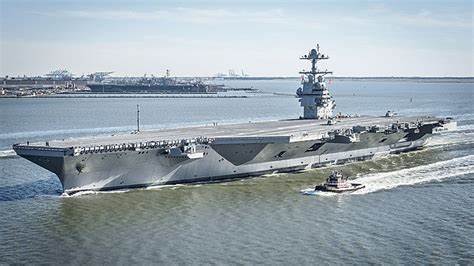
Earlier this year, the USS Gerald R. Ford, the U.S. Navy’s most advanced warship, the first in a new generation of aircraft carriers, embarks on a journey that not only showcases American naval power but also sparks a debate on the future of these behemoths in modern warfare.

Launched with a vision to supersede the formidable Nimitz-class carriers, the Ford-class carriers are the epitome of innovation, loaded with state-of-the-art technology and designed for increased efficiency and capability.

The USS Gerald R. Ford, or CVN-78, stands out as the pioneer, marking the first significant advancement in carrier technology in decades, featuring breakthroughs such as the Electromagnetic Aircraft Launch System (EMALS) and Advanced Arresting Gear (AAG). These upgrades enable an impressive sortie rate of up to 160 launches per day, which could peak at 220 in times of crisis.

Despite the grandeur of the USS Gerald R. Ford, questions loom over the relevancy of aircraft carriers in the face of contemporary and emerging threats. Hypersonic missiles, unmanned aerial vehicles, and cyber warfare present new challenges to these naval titans.

However, the U.S. Navy remains confident, having recently certified the Ford as a combat-deployable warship after extensive trials and simulations, including a final deployment for the certification of composite training unit exercise.

The concerns of vulnerability are not unfounded, as analysts ponder the implications of rapidly advancing anti-ship technology.

The Ford-class carriers, with their hefty $13 billion price tag each, could indeed be the last of their kind if they become too susceptible in contested environments. However, history shows the Navy’s adaptability and commitment to maintaining a qualitative edge through innovation.

While critics debate the future, the Ford-class continues to signify American naval dominance. The USS Gerald R. Ford has demonstrated its prowess by completing its first worldwide deployment to the Mediterranean earlier this year, effectively responding to the Israel-Hamas war with over 8,000 sorties. The carrier’s capability is unequivocal, but so is the evolving landscape of naval warfare.

It is an era where the Department of Defense awarded contracts totaling billions to Northrop Grumman Newport News’ shipbuilding division, Huntington Ingalls Industries, for the CVN-21 Aircraft Carrier Program, envisioning a fleet of ten Ford-class carriers by 2058.

The USS Gerald R. Ford is but the first, with the USS John F. Kennedy (CVN 79) and others following in the coming decades.

The Ford’s recent first combat deployment is a testament to its adaptability and lethality. As tensions rose with Houthi attacks on commercial shipping and the war with Israel, the Ford contributed significantly to U.S. regional deterrence and defense posture.

This reaffirms the Navy’s statement, which labels the Ford as the “most adaptable and lethal combat platform in the world.”

ABOARD THE USS DWIGHT D. EISENHOWER CVN-69 (01 Aug, 2000) While completing their six month deployment and transiting westward towards the mouth of the Atlantic Ocean, the crew of the USS DWIGHT D. EISENHOWER (CVN-69), display their teamwork and pride by strategically falling into ranks to spell out their name and accomplishments for a awesome aerial photograph. The IKE, and CARRIER AIRWING SEVEN are currently heading west toward the Atlantic after completing a successful six month deployment to the Med and Arabian Gulf. (Photo taken by Photographers Mate 2nd Class David E. Carter II; caption written by Seaman Pauly Soto)
As the USS Gerald R. Ford returns to its homeport of Norfolk, Virginia, the Navy reassures that its extensive capabilities remain formidable, with the USS Eisenhower continuing to patrol the region.

The presence of other U.S. Navy assets, like the amphibious assault ship USS Bataan carrying Marine Corps F-35 stealth fighters, and guided-missile destroyers, further bolsters the U.S. naval force.

Amidst this backdrop, the Navy conducts Operation Prosperity Guardian to enhance maritime security in the southern Red Sea, demonstrating a broader commitment to stability beyond the prowess of any single vessel.
Relevant articles:
– Ford-Class: Why This Might be the U.S. Navy’s Last Aircraft Carrier, The National Interest
– USS Gerald R. Ford Aircraft Carrier: The Pinnacle of Naval Power and Innovation, govconwire.com
– Ford-Class: The U.S. Navy’s Last Aircraft Carriers?, The National Interest
– USS Gerald R. Ford: US Navy’s largest aircraft carrier returning after extended Mediterranean deployment, CNN

